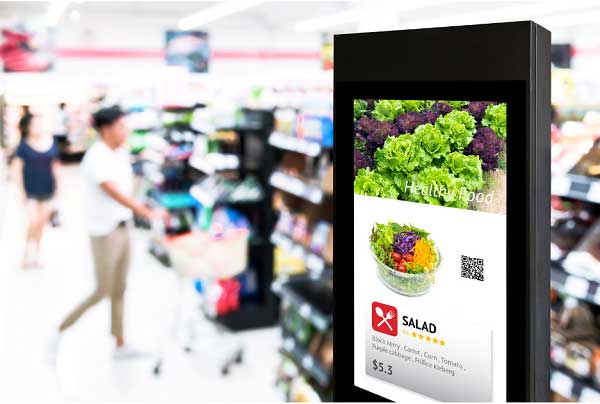Visual merchandising is a time-tested marketing tool to attract customers and hold their attention in physical retail. The retail practice involves strategically displaying the existing stock so that customers are compelled to walk through the store.
From window displays to the new-age, technology-aided digital in-store displays, visual merchandising is a means to create a brand identity and help create a seamless and satisfactory shopping experience for customers.
People had started to shop from the comfort of their homes, a situation that was further accelerated due to the pandemic. Therefore, brick-and-mortar stores must develop ingenious visual merchandising ideas to provide an enriching experience that cannot be achieved by shopping online. This trend is already picking up and we have seen it year after year in NRF’s Retail Big Show.
Several retailers are incorporating interactive technology in their premises to provide a blended experience to customers. For instance, they have smart mirrors in dressing rooms to help customers gauge how items would look when paired with other accessories to promote cross-selling. There is also the innovative concept of endless aisles available in in-store kiosks that help customers browse and order products that are not yet available in the store.
Importance of Signage
Any kind of graphic display that is used as a medium to convey information to an audience is known as signage. We come across signage many times in our daily lives. Road signs that talk about speed limits or directions to the nearest towns, health safety signs found in the workplace, colorful signboards in retail outlets detailing working hours, and information on discounts or deals are a few examples of signage.
Digital Signage in Retail tends to serve a few common purposes i.e.:
- Promotional campaigns or advertisements
- Establishing brand identity
- Visually appeal to attract customers
- Provide wayfinding & directional signs or raise health safety awareness.
Evolution of Digital Signage
The predecessor to digital signage was electronic paper, a display format that could hold static text and images indefinitely without electricity. Devices with electronic paper required manual intervention to update them with the latest information. Therefore, owing to the limited reach of information transmission, this format was soon replaced by the Dot Matrix display, which heralded the first generation of digital signage.
Commonly found in areas like train stations, and airports where mass communication is necessary, the Dot matrix display could relay information stored within a database on display devices such as LED boards, projection screens, OLED screens, etc. The downside of this type of digital signage is that it could not play multimedia content, leading to the second generation of digital signage called Multimedia Player digital signage.
As per its name, the second-generation digital signage can play multimedia content through a centrally managed system. Digital content is displayed on TVs and monitor displays of a digital sign network. The display content can also be controlled via the Digital Advertising Network players, which connect with the monitor and the internet, allowing the end user to dynamically change the content from a central location. Even more advanced digital signage software allows automatic content creation on a real-time basis by combining the most recent data obtained from news, weather reports, etc., with the audio-visual content to produce the most up-to-date content.
However, the second-generation digital signage lacked interactivity. This led to the third generation of digital signage, also known as interactive digital signage, where users could interact with the content management system.
Interactive digital signage enables greater interaction and thus offers a more personalized experience to the end-users.
Digital Signage in Retail
Retail was one of the first industries that started using signage and subsequently digital signage. In the early 1970’s, it harnessed the idea of “produce and play information repeatedly”. And in the 1990s, when the internet exploded, retailers combined with advertisers and technology companies to broadcast information on a larger scale outside the stores. History has it that the term digital signage was coined in the early ’90s by a security guard of a retail outlet in the UK. He was ignorant of what the network of video walls in the store was called and hence referred to them as digital signage.
Almost every retail outlet, regardless of size, uses digital signage. The mass usage of this technology is further facilitated by the reduction in the prices of hardware & software supporting digital signage. Whether it is used in the bright signage that helps in back-office employee management or the digital billboards, otherwise known as outdoor signage, which is becoming more prominent than ever with the option for large screens, digital signage is ubiquitous now.
Not to forget, QSRs have now resorted to digital menu boards that make ordering easier and help upsell products. There are also small businesses that use digital signage in retail to share promotions and sales as well as a larger chain of stores that can centrally manage the display content in real-time for their chain of stores
How Digital Signage Can Help Retailers Improve In-Store Marketing?
Once a customer enters a store, digital signage can be an apt substitute for marketing. Here are some ideas to show how digital signage can improve in-store marketing and add value to the overall marketing plan.
Promote Sales, make announcements, launch, and promote products:
Owing to its digital nature, digital signage can be thought of as a retailer’s virtual extension of its marketing channel where they can keep their customers updated with the latest announcements of sales, new product launches or even product promotions.
Effective Communication with customers:
While readily available customer service is a key differentiator between online and in-store shopping, digital signage can help in improving the in-store customer experience to a large extent.
Digital signage can be used for wayfinding in a store or to display exhaustive product catalogs to improve the shopping experience. They can even update customers with the occupancy levels in different areas of the store or follow social distancing in other areas of the stores.
Interactive channel to support sales staff:
By making use of interactive displays that can engage customers on multiple fronts, such as social channels for recommendations or product-specific information, retailers can enable customers to interact with the brand, thereby finding a conduit to share or deliver a personalized promotional message.
These screens provide additional customer support via signage that answers FAQs or connects to a team member for further assistance. These screens act like virtual extensions of the customer service teams, boosting team members’ productivity.
Build on brand recall:
Brand storytelling is believed to be 22 times more memorable than a repository of facts and figures. By running engaging videos on digital signage that communicate the brand identity and story to interested customers, retailers can provide information to customers and position the brand for an easy, top-of-the-mind recall.
Educate customers:
By showcasing engaging videos that provide more information about new or unfamiliar products or instructional videos that explain the working of a product, retailers can answer customer queries right at the beginning, expediting the buying process.
Increase revenue:
By placing digital signage near product displays, retailers can enlighten customers about complementary products or even suggest upgrading their products, thereby bringing in an opportunity to cross-sell or upsell as the situation demands. This would result in not only increased revenues from sales but will also significantly enhance customer experience by giving them a wide array of options to choose from.
Convert passers-by to prospective customers:
Digital Signage was initially introduced to attract customers to explore the offerings inside a retail store. By strategically placing digital signage outside the store, retailers can engagingly encourage passers-by to visit the store and turn into prospective customers.
Personalized engagement:
Enhanced algorithms power the third generation of digital signage, making it more interactive. By using additional technologies such as video analytics, retailers can leverage the data inside their stores to make their digital signage even smarter.
This means the digital signage can serve dynamic promotional content based on the real-time customer information obtained from the store, such as demography, expressions, etc.
Retail Digital Signage is a Necessity
All the above benefits point to the fact that digital displays will play an essential role in not just in-store marketing but also in the overall marketing strategy of retailers. You can use retail digital signage to bridge the divide between online and offline store presence, as it will help them focus more on customer experience.

Product Engineering Services Customized software development services for diverse domains
Sustenance Engineering Going beyond maintenance to prolong life of mature products
Managed Services Achieve scalability, operational efficiency and business continuity
Technology Consulting & Architecture Leverage the extensive knowledge of our Domain Experts




